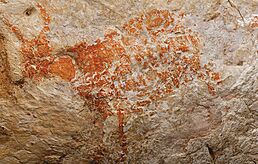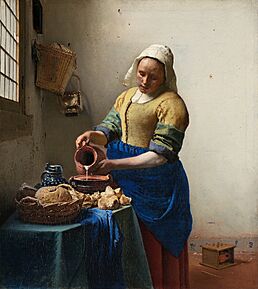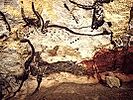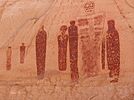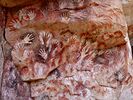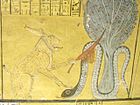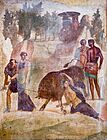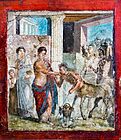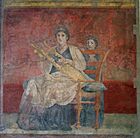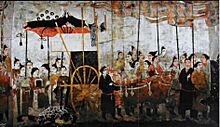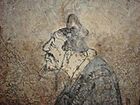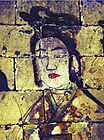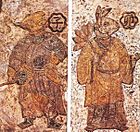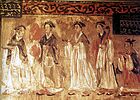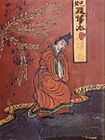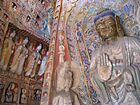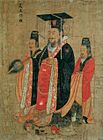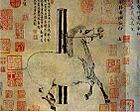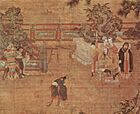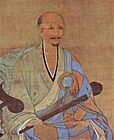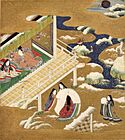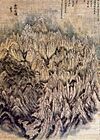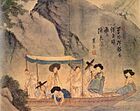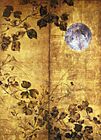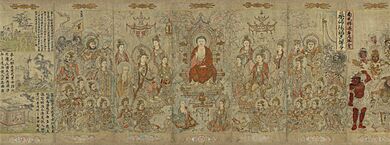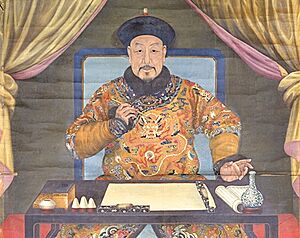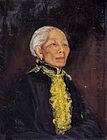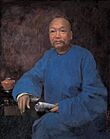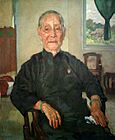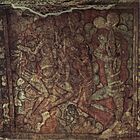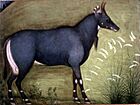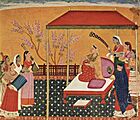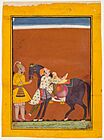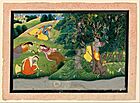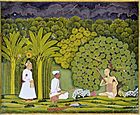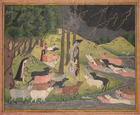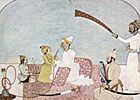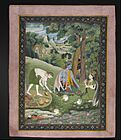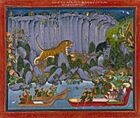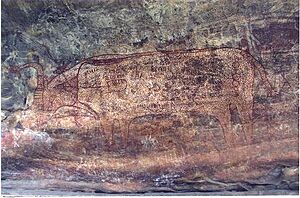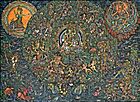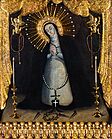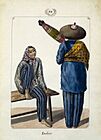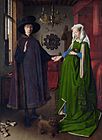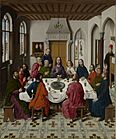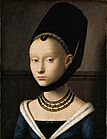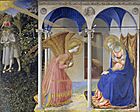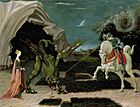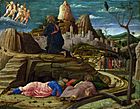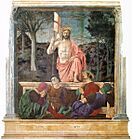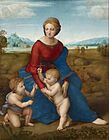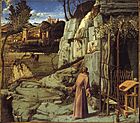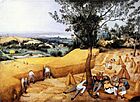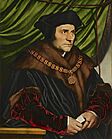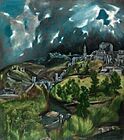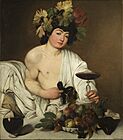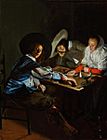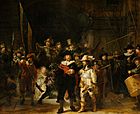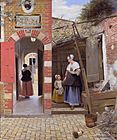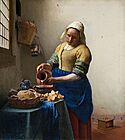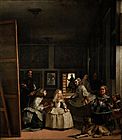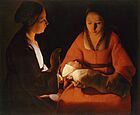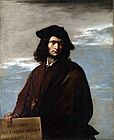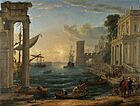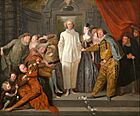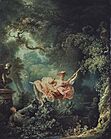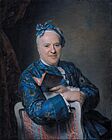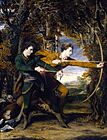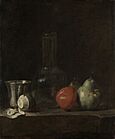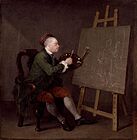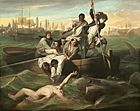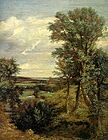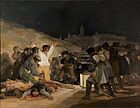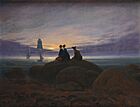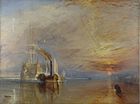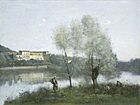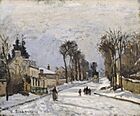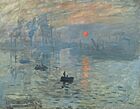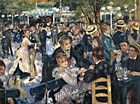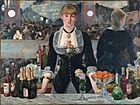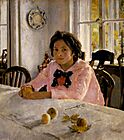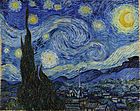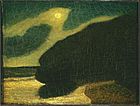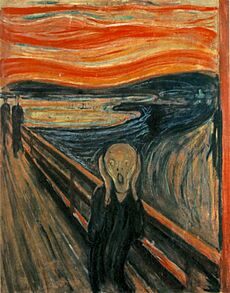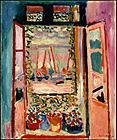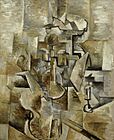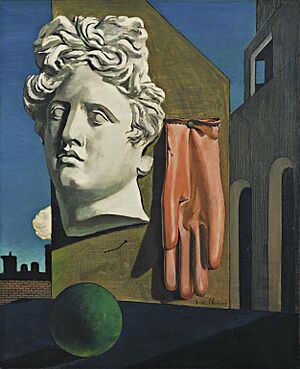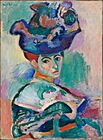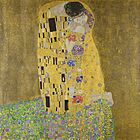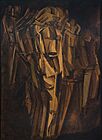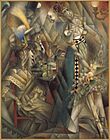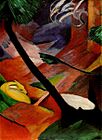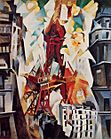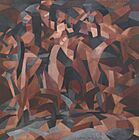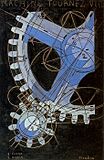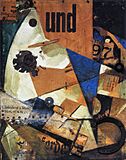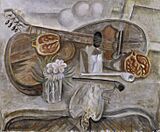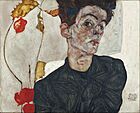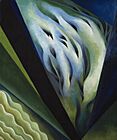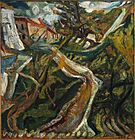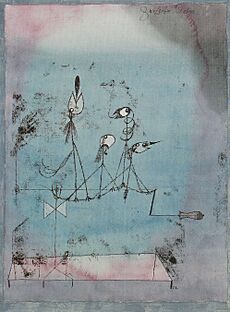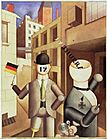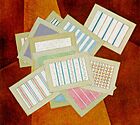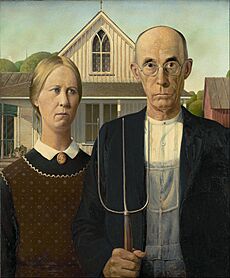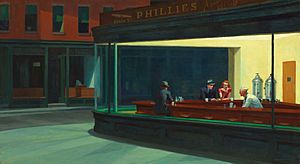History of painting facts for kids
Painting has a super long history, going back to the very first artists from ancient times. It's a creative journey that has continued through all cultures, continents, and thousands of years, right up to today! For a long time, until the early 1900s, most paintings showed real things like people, places, or religious stories. But after that, artists started exploring more abstract (non-realistic) and conceptual (idea-based) styles.
Painting styles in the East (like Asia) often developed in ways similar to those in the West (like Europe), sometimes even earlier. Art from places like Africa, Jewish cultures, Islamic cultures, Indonesia, India, China, and Japan has greatly influenced Western art, and Western art has also influenced them.
At first, paintings were used for practical things. Later, powerful rulers, rich families, and religious groups paid artists to create works. From the Middle Ages through the Renaissance, painters mostly worked for the church and wealthy nobles. In the Baroque era, artists started getting paid by a growing, educated middle class. Eventually, in the West, the idea of "art for art's sake" (meaning art is made just for its beauty, not for a special purpose) became popular with artists like Francisco de Goya and J. M. W. Turner. In the 1800s, art galleries started popping up, helping artists sell their work.
Contents
- Ancient Art: From Caves to Empires
- Eastern Painting: A Rich Tapestry of Cultures
- Western Painting: From Renaissance to Modern Art
- See also
Ancient Art: From Caves to Empires
Prehistoric Cave Paintings
The oldest known paintings are about 40,000 years old. They've been found in caves in Europe and Indonesia. The very first cave paintings were often handprints or simple shapes. The oldest clear pictures of animals are a bit younger, around 35,000 years old. In 2018, scientists found a painting of an unknown animal in a cave in Borneo (Indonesia) that was over 40,000 years old. Then, in 2019, even older cave paintings of pig hunting in Indonesia were found, dating back at least 43,900 years! This was called "the oldest pictorial record of storytelling." More recently, in 2021, a pig painting from an Indonesian island was dated to over 45,500 years old. Cave paintings exist all over the world, including in France, India, Spain, South Africa, China, and Australia.
People wonder what these ancient paintings meant. Maybe prehistoric artists painted animals to "capture" their spirit, hoping it would make hunting easier. Or perhaps the paintings showed respect for nature. They could also be a basic way for humans to express themselves, or even a way to share important information.
-
Lascaux, Horse
-
Eland, rock painting, Drakensberg, South Africa
-
Lascaux, Bulls and Horses
-
Spanish cave painting of Bulls
-
Petroglyphs, from Sweden, Nordic Bronze Age (painted)
-
Pictographs from the Great Gallery, Canyonlands National Park, Horseshoe Canyon, Utah, c. 1500 BCE
-
Cueva de las Manos (Spanish for Cave of the Hands) in the Santa Cruz province in Argentina, c. 7300 BC
-
Gwion Gwion rock paintings found in the north-west Kimberley region of Western Australia c. 15,000 BC
In the Paleolithic (Old Stone Age), paintings of humans were rare. Artists mostly painted animals, including those they hunted and powerful animals like rhinos or big cats, as seen in the Chauvet Cave. Simple signs like dots were sometimes added. Rare human pictures include handprints and figures that are half-human, half-animal. The Chauvet Cave in France has some of the most important Paleolithic cave paintings, from around 31,000 BC. The Altamira cave paintings in Spain (14,000 to 12,000 BC) show bison. The Hall of Bulls in Lascaux, France, is another famous cave painting, from about 15,000 to 10,000 BC.
The earliest known Indian paintings are prehistoric rock paintings, or petroglyphs, found in places like the Rock Shelters of Bhimbetka, some older than 5500 BC. This tradition continued for thousands of years. By the 7th century, the carved pillars of Ajanta Caves in India showed beautiful examples of Indian paintings. The colors, mostly reds and oranges, came from minerals.
Ancient Egypt, Greece, and Rome
Ancient Egypt had strong traditions in architecture and sculpture, which were originally painted in bright colors. They also had many wall paintings in temples and buildings, and painted pictures on papyrus scrolls. Egyptian wall painting is often very clear, sometimes more symbolic than realistic. Figures are shown with bold outlines and flat shapes, always with a sense of balance. Egyptian painting is closely linked to their written language, Egyptian hieroglyphs. Painted symbols were among the first forms of writing. Egyptians also painted on linen, and some pieces still exist today. The dry climate helped these ancient paintings survive. Egyptians created paintings to make the afterlife a pleasant place for the dead. Themes included journeys through the afterlife or protective gods introducing the deceased to underworld deities. Some paintings show activities the person enjoyed in life, hoping to continue them forever.
-
Ancient Egypt,The Goddess Isis, wall painting, c. 1360 BC
-
Ancient Egypt, Queen Nefertari
-
Ancient Egypt, papyrus
-
Pitsa panels, one of the few surviving panel paintings from Archaic Greece, c. 540–530 BC
-
Mural of soldiers from Agios Athanasios, Thessaloniki, Ancient Macedonia, 4th century BC
-
Fresco of an ancient Macedonian soldier (thorakitai) wearing chainmail armor and bearing a thureos shield, 3rd century BC
-
The Fall of Icarus, fresco from Pompeii, 40-79 AD
-
Roman art, Fayum mummy portraits from Roman Egypt
-
Cupids playing with a lyre, Roman fresco from Herculaneum
-
Roman fresco with a seated Venus, the so-called "Dea Barberini", 4th century AD
North of Egypt, the Minoan civilization on the island of Crete created wall paintings similar to Egyptian ones, but with a freer style. Mycenaean Greece, starting around 1600 BC, made art similar to Minoan Crete. During the Greek Dark Age, ancient Greek art became much simpler. But when Greek civilization grew again around the Mediterranean, new art forms appeared.
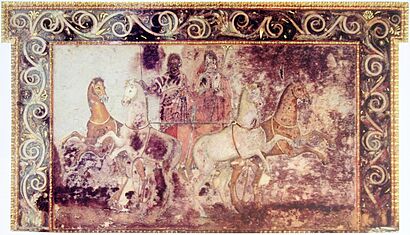
Ancient Greece had very skilled painters, sculptors, and architects. The Parthenon is a famous example of their architecture. Greek marble sculpture is often seen as the best example of Classical art. Paintings on ancient Greek pottery and ceramics give us a good idea of how society worked back then. Many examples of Greek painting survive on vases, showing scenes in black or red figures. Famous Greek painters on wooden panels, like Apelles and Zeuxis and Parrhasius, are mentioned in old texts, but few of their actual paintings exist today. Zeuxis, who lived around 5-6 BC, was said to be the first to use sfumato (a soft, hazy look). Stories say his painted grapes looked so real that birds tried to eat them! Apelles was known as the greatest painter of ancient times for his perfect drawing, bright colors, and modeling.
Roman art was influenced by Greece and can be seen as a continuation of ancient Greek painting. However, Roman painting also has its own special features. Surviving Roman paintings include wall paintings and frescoes, many from villas in Southern Italy like Pompeii and Herculaneum. These paintings can be grouped into four main "styles" and might include the first examples of trompe-l'œil (trick of the eye), fake perspective, and pure landscapes. Almost the only painted portraits from the ancient world that still exist are many coffin-portraits found in Egypt. Even though these weren't from the best period or the highest quality, they are still impressive and give us an idea of how good the best ancient art must have been.
Eastern Painting: A Rich Tapestry of Cultures
The history of Eastern painting includes many influences from different cultures and religions. Painting in the East often developed similarly to the West, sometimes even earlier. Art from places like Africa, Jewish cultures, Islamic cultures, Indonesia, India, China, Korea, and Japan has greatly influenced Western art, and Western art has also influenced them.
East Asian Painting: Ancient Traditions
Chinese painting is one of the oldest continuous art forms in the world. The earliest paintings were often decorative patterns, not realistic pictures. It was only during the Warring States period (403–221 B.C.) that artists started painting the world around them. Japanese painting is also very old and refined, with many styles. Its history is a mix of Japanese ideas and imported ones. Korean painting started around 108 B.C., making it one of the oldest in the world. This early art led to the styles of the Three Kingdoms of Korea period, especially the paintings in royal tombs.
-
A lacquerware painting from the State of Chu (704–223 BC), showing men in a two-horsed chariot.
-
Detail of a fresco showing the Chinese philosopher Confucius, from a Western Han (202 BC – 9 AD) tomb.
-
A Chinese woman, fresco from a Western Han (202 BC – 9 AD) tomb.
-
Paintings on tile of guardian spirits from the Han dynasty (202 BC – 220 AD).
-
Gentlemen in Conversation, tomb painting from the Eastern Han dynasty (25–220 AD).
-
Lacquerware basket from the Lelang Commandery, showing seated men, Eastern Han dynasty (25-220 AD).
-
Female court attendants, a mural from an Eastern Han (25-220 AD) tomb.
-
Female court attendants, a mural from an Eastern Han (25-220 AD) tomb.
-
Male figure from a lacquerware painting over wood, Northern Wei period, 5th century AD.
-
Buddhist art of painted relief sculptures from the Yungang Grottoes, Northern Wei dynasty (386-535 AD).
-
Emperor Sun Quan in the Thirteen Emperors Scroll, by Yan Liben (c. 600–673 AD), Chinese.
-
Eighty-Seven Celestials, by Wu Daozi (685–758), Tang dynasty, Chinese.
-
Portrait of Night-Shining White, by Han Gan, 8th century, Tang dynasty, Chinese.
-
Spring Outing of the Tang Court, by Zhang Xuan, 8th century, Tang dynasty, Chinese.
-
Servant, 8th century, Tang dynasty, Chinese.
-
Ladies making silk, a remake of an 8th-century original by Zhang Xuan by Emperor Huizong of Song, early 12th century, Chinese.
-
An illustrated sutra from the Nara period, 8th century, Japanese.
-
Ladies Playing Double Sixes, by Zhou Fang (730–800 AD), Tang dynasty, Chinese.
-
A Palace Concert, Tang dynasty, Chinese.
-
Night Revels, a Song dynasty remake of a 10th-century original by Gu Hongzhong.
-
Court portrait of Emperor Shenzong of Song (r. 1067–1085), Chinese.
-
Golden Pheasant and Cotton Rose, by Emperor Huizong of Song (r.1100–1126 AD), Chinese.
-
Listening to the Guqin, by Emperor Huizong of Song (1100–1126 AD), Chinese.
-
Chinese, anonymous artist of the 12th century Song dynasty.
-
Portrait of the Zen Buddhist Wuzhun Shifan, 1238 AD, Chinese.
-
A Man and His Horse in the Wind, by Zhao Mengfu (1254–1322 AD), Chinese.
-
Shukei-sansui (Autumn Landscape), Sesshu Toyo (1420–1506), Japanese.
-
Kanō Masanobu, 15th-century founder of the Kanō school, Zhou Maoshu Appreciating Lotuses, Japanese.
-
A White-Robed Kannon, Bodhisattva of Compassion, by Kanō Motonobu (1476–1559), Japanese.
-
Yi Ahm (1499–?), Mother Dog, 15th century, National Museum of Korea.
-
Tang Yin, A Fisher in Autumn, (1523), Chinese.
-
A screen painting depicting people playing Go, by Kanō Eitoku (1543–1590), Japanese.
-
Right panel of the Pine Trees screen (Shōrin-zu byōbu, 松林図 屏風) by Hasegawa Tōhaku (1539–1610), Japanese.
-
Scroll calligraphy of Bodhidharma, "Zen points directly to the human heart, see into your nature and become Buddha", Hakuin Ekaku (1686 to 1769), Japanese.
-
Genji Monogatari, by Tosa Mitsuoki (1617–1691), Japanese.
-
View of Geumgang, Jeong Seon (1676–1759), 1734, Korean.
-
Ike no Taiga (1723–1776), Fish in Spring, Japanese.
-
A tanuki (raccoon dog) as a tea kettle, by Katsushika Hokusai (1760–1849), Japanese.
-
Katsushika Hokusai, The Dragon of Smoke Escaping from Mt Fuji, Japanese.
-
Miyagawa Isshō, untitled Ukiyo-e painting, Japanese.
-
Tomioka Tessai (1837–1924), Nihonga style, Two Divinities Dancing, 1924, Japanese.
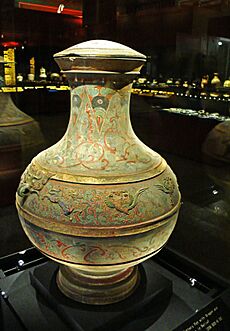
China, Japan, and Korea have a strong painting tradition, closely linked to calligraphy (fancy writing) and printmaking. East Asian painting often uses water-based techniques, is less realistic, and features "elegant" and simplified subjects. It focuses on shapes and lines, with lots of empty space, and often shows landscapes instead of people. Besides ink and color on silk or paper scrolls, gold on lacquer was also common. Silk was expensive, but the invention of paper in the 1st century AD made painting much more accessible.
Ideas from Confucianism, Daoism, and Buddhism were very important in East Asian art. For example, medieval Chinese painters like Lin Tinggui showed Buddhist ideas in their art. His "Luohan Laundering" (12th century) shows bald Buddhist monks washing clothes by a river. The monks are detailed and brightly colored, while the background is hazy and simple. This painting also uses "negative space" (empty areas) which is common in East Asian art.
In the late 1800s, European artists like Vincent van Gogh and James Abbott McNeill Whistler admired Japanese Ukiyo-e artists like Hokusai and Hiroshige. These Japanese artists greatly influenced the Europeans.
Chinese Painting: From Tombs to Landscapes
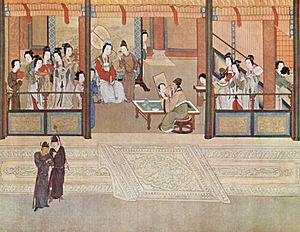
The oldest Chinese paintings that still exist are from the Warring States period (481–221 BC). These are paintings on silk or murals in tombs, often simple and geometric. They showed mythical creatures, daily life, work scenes, or palace scenes with officials. During this time and the following Qin dynasty (221–207 BC) and Han dynasty (202 BC – 220 AD), art wasn't just for personal expression. It was made to honor funerals, gods, or ancestors. Han dynasty paintings on silk showed court officials and daily life, as well as hunting or military parades. Even the Terracotta Army statues were originally painted with colors.
During the ancient Eastern Jin dynasty (316 – 420 AD), painting became a popular hobby for educated officials and nobles, along with music, calligraphy, and poetry. Painting became a way for artists to express themselves, and painters were judged by their peers.
The start of classical Chinese landscape painting is often credited to Gu Kaizhi (344 – 406 AD), one of China's most famous artists. Like Kaizhi's long scroll scenes, Tang dynasty (618–907 AD) artists like Wu Daozi painted detailed art on long horizontal scrolls. Tang period paintings often showed idealized landscapes with few objects or people, and often used one color. Early Tang painter Zhan Ziqian created amazing realistic landscapes. However, landscape art truly became mature and realistic during the Five Dynasties and Ten Kingdoms period (907–960 AD). During this time, there were great landscape painters like Dong Yuan, and artists who painted realistic daily scenes, like Gu Hongzhong's Night Revels of Han Xizai.
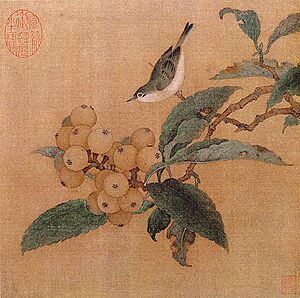
During the Chinese Song dynasty (960–1279 AD), landscape art improved, and portrait painting became more detailed and common. It reached its peak during the Ming dynasty (1368–1644 AD). In the late 1200s and early 1300s, Chinese people under Mongol rule (Yuan dynasty) couldn't get high government jobs. Many educated Chinese turned to art and theater instead, making the Yuan period a very lively time for Chinese art. For example, Qian Xuan (1235–1305 AD), a Song dynasty official, refused to work for the Yuan court and focused on painting. The Yongle Palace murals from 1262 AD are amazing examples of art from this time, covering over 1000 square meters with mostly Daoist themes. During the Song dynasty, painters also met to discuss and trade art. There were also many strong critics, showing different styles and tastes.
Even though Chinese painting often favored stylized, mystical, and elegant art over realism, many Chinese painters from the medieval Song dynasty onwards created very realistic nature scenes. Later Ming dynasty artists continued this focus on detailed realism, especially in paintings of animals among colorful flowers and plants. Qiu Ying is a great example of a famous Ming painter, known for his scenes of daily life, palaces, and misty mountain landscapes. The Ming dynasty also had different art schools, like the Wu School and the Zhe School.
Classical Chinese painting continued into the early modern Qing dynasty, with very realistic portraits. The portraits of the Kangxi, Yongzheng, and Qianlong Emperors are good examples. During the Qianlong era and the 1800s, European Baroque painting styles influenced Chinese portraits, especially with how light and shadow were used. Likewise, East Asian paintings and other art (like porcelain) were highly valued in Europe since the 1500s.
Chinese Oil Paintings: A Western Influence
Western oil painting techniques started coming to China in the 1800s and became popular among Chinese artists in the early 1900s. This happened as China connected more with the West. Artists like Li Tiefu, Xu Beihong, and Lin Fengmian traveled to Paris and Tokyo to learn Western art. Through them, art movements like Impressionism, Cubism, and Fauvism grew in China. This stopped during World War II and when the People's Republic of China was formed, as modern styles were seen as not fitting political ideas, and only realism was allowed. Still, the influence of Western art from the early 1900s remained. Oil painting stayed important in China, and traditional Chinese ink paintings also changed because of it.
Japanese Painting: Blending Styles

Japanese painting is one of the oldest and most refined Japanese arts, with many different styles. Like other Japanese arts, it developed by mixing native Japanese ideas with imported ones. Ukiyo-e, meaning "pictures of the floating world," is a type of Japanese woodblock print and painting from the 1600s to 1900s. It showed landscapes and theater scenes. Japanese printmaking, especially from the Edo period, greatly influenced French painting in the 1800s. In the 1800s, Japanese painters also developed a new style called yōga, which used Western painting techniques and materials. Famous artists in this style include Harada Naojirō and Kuroda Seiki.
Korean Painting: From Tombs to Confucianism
Korean painting started around 108 B.C., making it one of the oldest in the world. Early artworks developed into the styles of the Three Kingdoms of Korea period, especially the paintings in the tombs of Goguryeo royalty. During the Three Kingdoms period and the Goryeo dynasty, Korean painting mainly featured Korean-style landscapes, faces, Buddhist themes, and a focus on observing the sky, helped by advances in Korean astronomy. It wasn't until the Joseon dynasty that Confucian themes became important in Korean paintings, blending with native styles.
Korean painting often used black brushwork on mulberry paper or silk. This style is seen in "Min-Hwa" (colorful folk art), tomb paintings, and art for rituals and festivals, which used a lot of color.
South Asian Painting: Gods, Kings, and Miniatures
-
Mughal, Akbar Being Received by Khan Kilan, the Governor of Nagaur, in 1570.
-
Mughal nilgai, 1625–1650.
-
Emperor Shah Jahan and sons, c. 1628 or later. Mughal portraits usually show side views.
-
Sultan-Ibrahim-Adil-Shah-II-of-Bijapur. Miniature. Deccan, Bijapur; c. 1590. A three-quarter view which gives a powerful and lively impression of the sitter, despite lacking both Mughal precision, and very coherent modelling of the surfaces.
-
Pahari painting, Chamba, c. 1665, a warrior mounts his horse.
-
Kangra painting, c. 1775, Krishna plays his flute to the gopis.
-
Ravana kills Jathayu; the captive Sita despairs, by Raja Ravi Varma.
-
Akbar and Tansen Visit Haridas in Vrindavan, Rajasthan style, c. 1750.
Indian Painting: From Caves to Miniatures
Indian paintings traditionally focused on religious gods and goddesses, and kings. Indian art includes several different art styles from the Indian subcontinent. Paintings ranged from large frescoes in Ajanta Caves to tiny Mughal miniature paintings and metal-decorated works from the Tanjore school. Paintings from the Gandhar–Taxila region were influenced by Persian art. The eastern style of painting mostly developed around the Nalanda school of art. Many works are inspired by scenes from Hindu mythology.
History of Indian Painting

The earliest Indian paintings are prehistoric rock paintings, or petroglyphs, found in places like the Rock Shelters of Bhimbetka, some older than 5500 BC. This tradition continued for thousands of years. By the 7th century, the carved pillars of Ajanta Caves in Maharashtra state showed beautiful examples of Indian paintings. The colors, mostly reds and oranges, came from minerals.
Ajanta Caves in Maharashtra, India, are cave monuments carved into rock, dating back to the 2nd century BCE. They contain paintings and sculptures considered masterpieces of both Buddhist religious art and universal art.
- Madhubani painting
Madhubani painting is a style of Indian painting from the Mithila region of Bihar state, India. Its origins are very old.
Mughal Painting
Mughal painting is a specific style of Indian painting, usually small illustrations in books. It grew and developed during the Mughal Empire from the 1500s to the 1800s.
Rajput Painting
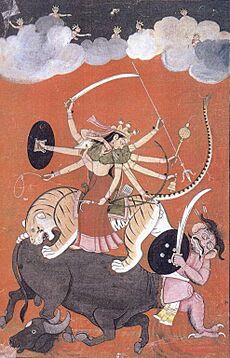
Rajput painting grew and became popular in the 1700s in the royal courts of Rajputana, India. Each Rajput kingdom developed its own style, but they shared some common features. Rajput paintings show many themes, like stories from epics such as the Ramayana and Mahabharata, Krishna's life, beautiful landscapes, and people. Small miniature paintings were the most common form of Rajput painting. Many manuscripts also have Rajput paintings, and paintings were even done on the walls of palaces and forts.
The colors came from minerals, plants, shells, and even precious stones, gold, and silver. Making the colors was a long process, sometimes taking weeks. The brushes used were very fine.
Tanjore Painting
Tanjore painting is an important style of classical South Indian painting from the town of Tanjore in Tamil Nadu. This art form dates back to the early 800s, a time when the Chola rulers encouraged art and literature. These paintings are known for their elegance, rich colors, and detailed work. Most of them show Hindu Gods and Goddesses and scenes from Hindu mythology. Today, these paintings are popular souvenirs during festivals in South India.
Making a Tanjore painting involves many steps. First, a rough sketch is drawn on a cloth glued to a wooden base. Then, chalk powder or zinc oxide mixed with glue is applied to the base. Sometimes, it's smoothed with a mild sander. After the drawing, jewelry and clothes in the picture are decorated with semi-precious stones, laces, or threads. Gold foils are then glued on top. Finally, dyes are used to color the figures.
Madras School of Art
During British rule in India, the British found that Madras had very talented artists. Since the British had a large settlement there, they chose Georgetown to set up an art institute for the royal family in London. This became known as the Madras School of Art. At first, traditional artists made beautiful furniture, metalwork, and curiosities, which were sent to the Queen's palaces.
Unlike the Bengal School, where copying was common, the Madras School focused on creating new styles and ideas.
Bengal School of Art
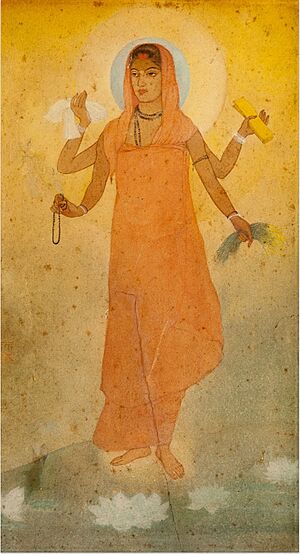
The Bengal school of art was an important art style that grew in British India in the early 1900s. It was linked to Indian nationalism but was also supported by many British art leaders.
The Bengal School started as a new, nationalist movement against the traditional art styles promoted in India by both Indian artists and British art schools. After Indian spiritual ideas became popular in the West, the British art teacher Ernest Binfield Havel tried to change teaching methods at the Calcutta School of Art. He encouraged students to copy Mughal miniatures. This caused a lot of debate, leading to student strikes and complaints from the local press, including nationalists who thought it was a step backward. Havel was supported by artist Abanindranath Tagore, who painted works influenced by Mughal art. He and Havel believed this style showed India's unique spiritual qualities, unlike the "materialism" of the West. Tagore's most famous painting, Bharat Mata (Mother India), showed a young woman with four arms, like Hindu gods, holding symbols of India's national hopes. Tagore later tried to connect with Japanese artists to create a pan-Asian art style.
The Bengal School's influence in India decreased as modern art ideas spread in the 1920s. After India became independent in 1947, Indian artists became more flexible. They freely borrowed from European styles and mixed them with Indian themes to create new art forms. While artists like Francis Newton Souza and Tyeb Mehta were more Western in their approach, others like Ganesh Pyne and Maqbool Fida Husain developed truly Indian styles. Today, with India's economy opening up, artists are getting more international exposure. This helps them create new art forms not seen before in India.
Modern Indian Painting
Amrita Sher-Gil was an Indian painter, sometimes called India's Frida Kahlo. She is considered an important woman painter of 20th-century India, as famous as the Masters of the Bengal Renaissance. She is also India's "most expensive" woman painter.
Today, she is one of "Nine Masters" whose work was declared "art treasures" by The Archaeological Survey of India in 1976 and 1979. Over 100 of her paintings are now displayed at the National Gallery of Modern Art in New Delhi.
During the time of British rule, Western influences started to affect Indian art. Some artists developed a style that used Western ideas of composition, perspective, and realism to show Indian themes. Others, like Jamini Roy, purposely took inspiration from folk art.
By the time India gained independence in 1947, several art schools in India offered modern techniques and ideas. Galleries were set up to show these artists' works. Modern Indian art usually shows Western influences but is often inspired by Indian themes and images. Major artists are starting to get international recognition, first among Indians living abroad, and then among non-Indian audiences.
The Progressive Artists' Group, formed shortly after India became independent in 1947, aimed to create new ways of expressing India in the post-colonial era. The founders were six famous artists: K. H. Ara, S. K. Bakre, H. A. Gade, M.F. Husain, S.H. Raza, and F. N. Souza. Although the group broke up in 1956, it greatly changed Indian art. Almost all major Indian artists in the 1950s were part of this group. Some well-known names today include Bal Chabda, Manishi Dey, Mukul Dey, V. S. Gaitonde, Ram Kumar, Tyeb Mehta, and Akbar Padamsee. Other famous painters like Jahar Dasgupta, Prokash Karmakar, John Wilkins, Narayanan Ramachandran, and Bijon Choudhuri enriched India's art culture. They became icons of modern Indian art.
Indian art got a boost when the country's economy opened up in the early 1990s. Artists from different fields started bringing in various styles. In post-liberalization India, many artists have become famous in the international art market, like abstract painter Natvar Bhavsar, figurative artist Devajyoti Ray, and sculptor Anish Kapoor, whose huge artworks have gained attention for their size. Many art houses and galleries have also opened in the USA and Europe to show Indian artworks.
Southeast Asian Painting: Ancient Roots and Modern Styles
Indonesian Painting: From Caves to Modern Art
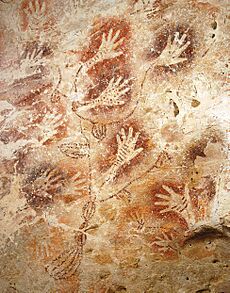
The oldest known cave paintings are over 44,000–50,000 years old, found in the caves in the district of Maros (Sulawesi, Indonesia). The oldest types are hand stencils and simple shapes. The oldest clear animal paintings are a bit younger, around 35,000 years old.
The discovery of the then-oldest known animal painting, over 40,000 (perhaps up to 52,000) years old, was in the cave of Lubang Jeriji Saléh on the Indonesian island of Borneo. In December 2019, however, even older cave paintings of pig hunting in Sulawesi were found, estimated to be at least 43,900 years old. This was called "the oldest pictorial record of storytelling."
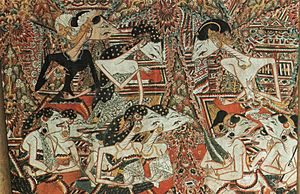
Other Indonesian paintings include Kenyah decorative art, which uses local plant and animal designs like ferns and hornbills, found on the walls of Kenyah longhouses. Another important traditional art is the geometric Toraja wood carvings. Balinese paintings originally told stories from Balinese legends and religious texts. Classical Balinese paintings often decorated lontar manuscripts and temple ceilings. Famous modern Indonesian painters who used European styles include Raden Saleh and Basuki Abdullah. Their art explores landscapes and portraits.
-
Capture of Prince Diponegoro, 1857.
Filipino Painting: A Mix of Cultures

Filipino painting is a blend of many cultural influences, though it mostly looks Western now, with Eastern roots.
Early Filipino painting can be seen in red clay designs on ritual pottery, like the Manunggul Jar. Evidence of pottery-making in the Philippines dates back as early as 6000 BC. By 5000 BC, pottery was made throughout the country. Filipinos started making pottery before their Cambodian neighbors and at about the same time as the Thais. Further evidence of painting is found in the tattoo tradition of early Filipinos, especially the Visayans, whom Spanish explorers called Pintados (Painted People). They decorated their bodies with colorful designs of plants, animals, and heavenly bodies. Some of the most detailed early Filipino paintings that still exist are among the arts and architecture of the Maranao people. They are known for their Nāga Dragons and Sarimanok carvings and paintings on the beautiful Panolong of their Torogan (King's House).
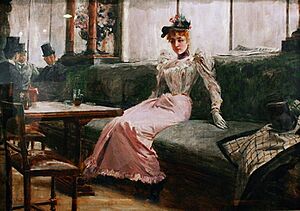
Filipinos began painting in the European style during the 1600s, when Spain ruled. The first paintings were church frescoes and religious images from the Bible, as well as prints and sculptures of Christian figures and European royalty. Most paintings from the 1800s and 1900s were a mix of religious, political, and landscape art, with qualities of sweetness, darkness, and light. Early modernist painters like Damián Domingo were known for religious and everyday paintings. The art of Juan Luna and Félix Hidalgo showed a trend towards political statements. Artists like Fernando Amorsolo used post-modernism to create paintings that showed Philippine culture, nature, and harmony. Other artists like Fernando Zóbel used realism and abstraction in their work.
-
Fabián de la Rosa, Women Working in rice field, 1902.
-
Juan Luna, Tampuhan, 1895.
Western Painting: From Renaissance to Modern Art
The Renaissance and Mannerism: New Ideas and Styles
-
Robert Campin, c. 1425.
-
Jan van Eyck, 1434.
-
Rogier van der Weyden, c. 1435.
-
Hugo van der Goes, c. 1470.
-
Dieric Bouts, 1464–1467.
-
Fra Angelico, 1425–1428.
-
Paolo Uccello, c. 1470.
-
Andrea Mantegna, c. 1458–1460.
-
Piero della Francesca, 1463–1465.
-
Sandro Botticelli, 1483–1485.
-
Leonardo da Vinci, 1503–1506.
-
Raphael, 1505–1506.
-
Albrecht Dürer, 1500.
-
Matthias Grünewald, 1512–1516.
-
Giovanni Bellini, c. 1480.
-
Pieter Bruegel, 1565.
-
Hans Holbein the Younger, 1527.
-
Paolo Veronese, 1562–1563.
-
El Greco, 1596–1600.
The Renaissance, meaning 'rebirth' in French, was a cultural movement from the 1300s to the mid-1600s. It brought back the study of classical ideas and saw advances in science that greatly changed European thought and art. In the Low Countries (like modern-day Flanders), a new painting style emerged in the early 1400s. Artists became fascinated by the real world and started painting objects very realistically. The use of oil painting (though not invented by Jan van Eyck, he made it famous) allowed for new realism. Oil paint created richer, deeper colors and a glowing, porcelain-like finish, different from the matte look of tempera paint used in Italy. Unlike Italian artists who looked to ancient Greece and Rome, Northern artists kept some of the style from medieval sculptures and illuminated manuscripts.
The most important artist of this time was Jan van Eyck, whose work is among the best by the Early Netherlandish painters. Another key painter was Rogier van der Weyden, who focused on human emotion and drama, as seen in his Descent from the Cross. Other important artists include Hugo van der Goes and Dieric Bouts.
In Italy, art from Classical antiquity inspired a painting style that focused on the ideal. Artists like Paolo Uccello, Masaccio, Leonardo da Vinci, Michelangelo Buonarroti, and Raphael improved painting through perspective, studying human anatomy, and developing very refined drawing and painting techniques. A more natural style appeared in Venice. Painters of the Venetian school, like Giovanni Bellini and Titian, cared less about perfect drawing and more about rich color and overall effect, using a more spontaneous approach.
Flemish, Dutch, and German Renaissance painters like Hans Holbein the Younger, Albrecht Dürer, and Pieter Bruegel had a different approach from their Italian peers. Their work was more realistic and less idealized. Genre painting (scenes of everyday life) became popular among Northern painters.
Renaissance painting shows the revolution in ideas and science (like astronomy and geography), the Protestant Reformation, and the invention of the printing press. Dürer believed painters were not just craftspeople but also thinkers. With the rise of easel painting in the Renaissance, painting became more independent from architecture. Easel paintings were movable pictures that could be hung on walls, becoming a popular alternative to paintings fixed to furniture or walls. After centuries dominated by religious art, everyday subjects slowly returned to Western painting. Artists included visions of the world around them or their own imaginations. Wealthy people could become patrons and commission portraits of themselves or their families.
The High Renaissance led to a more stylized art called Mannerism. Instead of the balanced compositions and clear perspective of early 1500s art, Mannerists aimed for instability, artificiality, and doubt. The calm faces of Piero della Francesca and Raphael were replaced by the troubled expressions of Pontormo and the strong emotions of El Greco. Restless compositions, extreme perspectives, and stylized poses are typical of Italian Mannerists like Tintoretto and Bronzino, and later appeared in the work of Northern Mannerists.
Baroque and Rococo: Drama and Decoration
-
Caravaggio, 1595–1597.
-
Frans Hals, 1624.
-
Judith Leyster, 1630.
-
Rembrandt van Rijn, 1642.
-
Pieter de Hooch, 1658.
-
Johannes Vermeer, c. 1660.
-
Jan Steen, c. 1665.
-
Jacob van Ruisdael, 1670.
-
Willem Claesz. Heda, 1631.
-
Diego Velázquez, 1656–1657.
-
Jusepe de Ribera, 1620–1624.
-
Nicolas Poussin, c. 1637–1638.
-
Georges de La Tour, 1640s.
-
Guido Reni, 1625.
-
Salvator Rosa, c. 1645.
-
Bartolomé Esteban Murillo, c. 1650–1655.
-
Anthony van Dyck, 1635–1636.
-
Antoine Watteau, c. 1720.
-
Jean-Honoré Fragonard, c. 1767–1768.
-
Élisabeth Louise Vigée-Le Brun, after 1782.
-
Maurice Quentin de La Tour, c. 1761.
-
Thomas Gainsborough, c. 1770.
-
Joshua Reynolds, 1769.
-
Jean-Baptiste-Siméon Chardin, c. 1728.
-
William Hogarth, c. 1757.
-
Angelica Kauffman, c. 1780.
Baroque painting is part of the Baroque cultural movement, which lasted from about 1600 through the 1600s. It's known for great drama, rich colors, and strong contrasts between light and dark shadows. Baroque art aimed to stir up strong feelings and passion, rather than the calm, logical feeling of the Renaissance. Some of the greatest Baroque painters include Caravaggio, Rembrandt, Frans Hals, Rubens, Velázquez, Poussin, and Johannes Vermeer. Caravaggio's realistic way of painting people, often lit dramatically against a dark background, shocked people at the time and started a new chapter in painting.
Baroque paintings often use light effects to make scenes more dramatic. This can be seen in works by Rembrandt, Vermeer, and La Tour.
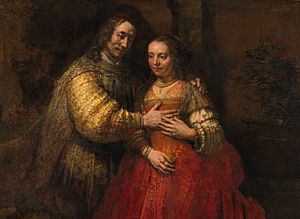
In Italy, the Baroque style is best shown in religious and mythological paintings by artists like the Carracci and Guido Reni. Huge church ceiling frescoes by Pietro da Cortona seemed to open up to the sky. A quieter type of Baroque appeared in the Dutch Republic. Here, paintings of everyday subjects were popular with middle-class buyers. Many painters became experts in genre painting (scenes of daily life), while others specialized in landscapes, seascapes, or still life. Vermeer, Gerard ter Borch, and Pieter de Hooch brought great skill to painting domestic scenes, as did Willem Claesz. Heda to still life. In contrast, Rembrandt was excellent at painting all kinds of subjects and developed his own unique style, where the strong light and dark (chiaroscuro) and dark backgrounds from Caravaggio became less theatrical.
During the 1700s, Rococo followed as a lighter, more decorative version of Baroque. Rococo first developed in France in decorative arts and interior design. When Louis XV became king, court artists and general art fashion changed. The 1730s were the peak of Rococo in France, with works by Antoine Watteau and François Boucher. Rococo still had the Baroque love for complex shapes and detailed patterns, but it started to include different features, like a taste for Asian designs and unbalanced compositions.
The Rococo style spread with French artists and printed works. It was easily accepted in Catholic parts of Germany, Bohemia, and Austria, where it blended with lively German Baroque traditions. German Rococo was used with enthusiasm in churches and palaces, especially in the south.
French masters Watteau, Boucher, and Fragonard represent the style. Giovanni Battista Tiepolo and Jean-Baptiste-Siméon Chardin (considered by some the best French painter of the 1700s, known as the Anti-Rococo) also represent it. Portrait painting was important everywhere, but especially in England, where leaders included William Hogarth (with a direct, realistic style) and Thomas Gainsborough and Joshua Reynolds (with more flattering styles influenced by Anthony van Dyck). In France during the Rococo era, Jean-Baptiste Greuze excelled in portraits and history paintings. Maurice Quentin de La Tour and Élisabeth Vigée-Lebrun were very skilled portrait painters. La Tour specialized in pastel painting, which became popular then.
19th Century: From Classicism to Impressionism
-
Jacques-Louis David 1787.
-
John Singleton Copley 1778.
-
John Constable 1802.
-
Francisco de Goya 1814.
-
Théodore Géricault 1819.
-
Caspar David Friedrich c.1822.
-
J. M. W. Turner 1838.
-
Gustave Courbet 1849–1850.
-
Ivan Aivazovsky 1850.
-
Albert Bierstadt 1866.
-
Camille Corot c.1867.
-
Ilya Repin 1870–1873.
-
Camille Pissarro 1872.
-
Claude Monet 1872.
-
Pierre-Auguste Renoir 1876.
-
Edgar Degas 1876.
-
Édouard Manet 1882.
-
Georges Seurat 1884–1886.
-
Valentin Serov 1887.
-
Vincent van Gogh 1889.
-
Albert Pinkham Ryder 1890.
-
Winslow Homer 1899.
After Rococo, in the late 1700s, a strict style called neo-classicism appeared in architecture and then in painting. Artists like David and Ingres were its best examples.
This movement focused on landscapes and nature, as well as the human figure. It showed that nature's power was greater than human will. This idea was different from ancient Greek and Renaissance beliefs, where humans were seen as controlling their own destiny. This led Romantic artists to paint dramatic scenes, ruined churches, shipwrecks, and themes of madness.
By the mid-1800s, painters were free from only painting religious, mythological, portrait, or historical scenes. The idea of "art for art's sake" (art for its own beauty) started to appear in the work of painters like Francisco de Goya, John Constable, and J. M. W. Turner. Romantic painters saw landscape painting as an important way to show how small humans are compared to the grandeur of nature. Before this, landscape painting wasn't considered as important as portraits or history paintings. But artists like J.M.W. Turner and Caspar David Friedrich raised landscape painting to a high level.
Some major painters of this period are Eugène Delacroix, Théodore Géricault, J. M. W. Turner, Caspar David Friedrich, and John Constable. Francisco de Goya's later work shows the Romantic interest in the strange and illogical.

The leading Barbizon School painter Camille Corot painted in both romantic and realistic styles. His work, and that of Eugène Boudin (who painted outdoors), hinted at Impressionism. Boudin greatly influenced a young Claude Monet, introducing him to painting outside in 1857. A major force in the shift towards Realism in the mid-century was Gustave Courbet. In the last third of the century, Impressionists like Édouard Manet, Claude Monet, Pierre-Auguste Renoir, Camille Pissarro, Alfred Sisley, Berthe Morisot, Mary Cassatt, and Edgar Degas used a more direct approach. They avoided complex stories and focused on their personal reactions to the modern world. They often painted with little preparation, using skillful drawing and bright colors. Manet, Degas, Renoir, Morisot, and Cassatt mainly focused on people. Monet, Pissarro, and Sisley used landscapes as their main subject, with light and weather playing a big role.
Slightly younger Post-Impressionists like Vincent van Gogh, Paul Gauguin, and Georges Seurat, along with Paul Cézanne, pushed art towards modernism. For Gauguin, Impressionism led to personal symbolism. Seurat turned Impressionism's broken colors into a scientific study of optics. Van Gogh's wild way of applying paint and his strong use of color predicted Expressionism. Cézanne, who wanted to combine classical composition with a new way of simplifying natural forms, is seen as a forerunner of 20th-century art.
Impressionism spread worldwide, including in the United States, where it became part of the work of American Impressionists like Childe Hassam. It also influenced painters who weren't strictly Impressionistic, like portrait and landscape painter John Singer Sargent. At the same time in America, around 1900, a unique realism existed, seen in the works of Thomas Eakins and the landscapes of Winslow Homer.
In the late 1800s, there were also several different groups of Symbolist painters whose work influenced younger artists of the 1900s, especially the Fauvists and Surrealists. These included Gustave Moreau, Odilon Redon, Edvard Munch, and Gustav Klimt.
Symbolist painters used mythology and dream images to create a visual language of the soul, aiming for evocative paintings that suggested a quiet, still world. The symbols they used were not common ones but deeply personal, private, and sometimes unclear. More of a philosophy than an art style, Symbolist painters influenced the Art Nouveau movement. In their exploration of dreamlike subjects, symbolist painters are found across centuries and cultures, and still exist today.
20th Century: Modern and Contemporary Art
The legacy of painters like Van Gogh, Cézanne, Gauguin, and Seurat was very important for the development of modern art. In the early 1900s, Henri Matisse and other young artists changed the art world in Paris with "wild," colorful, expressive landscapes and figure paintings that critics called Fauvism. Pablo Picasso made his first cubist paintings based on Cézanne's idea that all nature can be broken down into three basic shapes: cube, sphere, and cone.
Pioneers of 20th-Century Art
-
Henri Matisse 1905, Fauvism.
-
Georges Braque 1910, Analytic Cubism.
-
Henri Rousseau 1910 Primitive Surrealism.
The work of painters like Van Gogh, Cézanne, Gauguin, and Seurat was key to modern art. In the early 1900s, Henri Matisse and other young artists, including Georges Braque and André Derain, changed the Paris art scene with "wild," colorful, expressive landscapes and figure paintings. Critics called this style Fauvism. Henri Matisse's The Dance (second version) was a major moment in his career and in modern painting. It shows Matisse's early interest in primitive art. Pablo Picasso made his first cubist paintings based on Cézanne's idea that all of nature can be broken down into cubes, spheres, and cones. Analytic Cubism was developed by Picasso and Georges Braque from about 1908 to 1912. This was followed by synthetic cubism, which added different textures, surfaces, collage elements, and a mix of subjects.
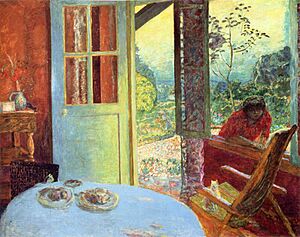
Les Fauves (French for The Wild Beasts) were early 20th-century painters who experimented with expressing themselves freely through color. The name was given to them humorously by an art critic. Fauvism was a short-lived group of artists whose works focused on painterly qualities and bold use of deep color, rather than just showing things realistically. Fauvists made the subject easy to see, exaggerated perspectives, and used bright colors to create a sense of calm. The leaders were Henri Matisse and André Derain. Other Fauvist painters included Albert Marquet and Maurice de Vlaminck.
Fauvism was a short-lived movement, from 1905 to 1907, with no strict rules. Matisse was seen as the leader. His 1905 portrait The Green Line caused a stir in Paris. He said he wanted to create art to delight, and his use of bright colors aimed for calm compositions. By 1907, Fauvism was replaced by Cubism as the newest art trend.
In 1907, Guillaume Apollinaire said about Matisse, "Matisse's art is very reasonable." Analytic cubism was developed by Pablo Picasso and Georges Braque from about 1908 to 1912. This was followed by Synthetic cubism, which added different textures, surfaces, collage elements, and a mix of subjects.
Between 1910 and the end of World War I, after Cubism's peak, several movements appeared in Paris. Giorgio de Chirico moved to Paris in 1911. His mysterious paintings are considered important to the early beginnings of Surrealism. Throughout the first half of the 1900s in Europe, masters like Georges Braque and André Derain continued painting independently of any movement.
Pioneers of Modern Abstraction
-
André Derain, 1905, Le séchage des voiles (The Drying Sails), Fauvism.
-
Henri Matisse, 1905, Woman with a Hat, Fauvism.
-
Gustav Klimt, expressionism, 1907–1908.
-
Pablo Picasso, 1908, Dryad, Proto-Cubism.
-
Marc Chagall 1911, expressionism and surrealism.
-
Marcel Duchamp, 1911–1912, Cubism and Dada.
-
Albert Gleizes, 1912, l'Homme au Balcon, Man on a Balcony (Portrait of Dr. Théo Morinaud), Cubism.
-
Jean Metzinger, 1912, Danseuse au café (Dancer in a café), Cubism.
-
Franz Marc 1912, Der Blaue Reiter.
-
Robert Delaunay, 1911, Orphism.
-
Francis Picabia, 1912, La Source (The Spring), Abstract art.
-
Wassily Kandinsky 1913, birth of abstract art.
-
Amedeo Modigliani, Portrait of Soutine 1916, example of Expressionism.
-
Fernand Léger 1919, synthetic Cubism, tubism.
In the first two decades of the 1900s, after Cubism, several other important movements appeared. These included futurism (Balla), abstract art (Kandinsky), Bauhaus (Kandinsky and Klee), Orphism (Robert Delaunay), De Stijl (Mondrian), Suprematism (Malevich), Dadaism (Duchamp), and Surrealism (De Chirico). Modern painting influenced all visual arts, from architecture to film, and became a place for experimenting with visual expression. Van Gogh's painting greatly influenced 20th-century Expressionism, seen in the work of the Fauves and Die Brücke.
Wassily Kandinsky, a Russian painter, is generally seen as the first important painter of modern abstract art. He believed that pure visual abstraction could express pure spirituality. His early abstract works were often titled like Composition VII, connecting to music. Kandinsky wrote about his theories in his book Concerning the Spiritual in Art. Robert Delaunay was a French artist linked to Orphism, which connected pure abstraction and cubism. His later works were more abstract. His bold use of color and love for experimentation were key to abstract painting.
Other major pioneers of early abstraction include Russian painter Kasimir Malevich and Swiss painter Paul Klee, whose color experiments made him an important pioneer of abstract painting at the Bauhaus. Other important pioneers include Swedish artist Hilma af Klint and American artists Stanton Macdonald-Wright and Morgan Russell, who started Synchromism in 1912.
Expressionism and Symbolism are broad terms for several important movements in 20th-century painting, mostly in Europe. Expressionist works were painted between World War I and World War II. Expressionist artists are linked to Surrealism and Symbolism, and their work is very personal. Fauvism, Die Brücke, and Der Blaue Reiter are three well-known groups of Expressionist and Symbolist painters.
Artists like Marc Chagall, whose painting I and the Village tells a personal story using artistic Symbolism, were influential. Other important expressionist painters included Gustav Klimt, Egon Schiele, Edvard Munch, and Amedeo Modigliani.
Dada and Surrealism: Art of Dreams and Rebellion
-
Francis Picabia 1916, Dada.
-
Kurt Schwitters, 1919, painted collage, Dada.
-
Max Ernst, 1921, Surrealism.
-
André Masson, 1922, early Surrealism.
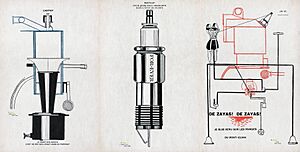

Marcel Duchamp became famous after his success at the New York City Armory Show in 1913. After his Nude Descending a Staircase became a sensation, he created The Bride Stripped Bare by Her Bachelors, Even, Large Glass. This work pushed painting to new limits, being part painting, part collage, and part construction. Duchamp was closely linked to the Dada movement, which started in Switzerland during World War I and peaked from 1916 to 1920. Dada involved visual arts, literature, and theater, and showed its anti-war message by rejecting traditional art standards. Francis Picabia, Man Ray, and Kurt Schwitters were also part of Dada. Duchamp and several Dadaists are also linked to Surrealism, which was popular in European painting in the 1920s and 1930s.
In 1924, André Breton published the Surrealist Manifesto. The Surrealist movement in painting became known for its new and experimental art, with works ranging from abstract to super-realistic. With works like Machine Turn Quickly, Francis Picabia continued his involvement in Dada until 1919, then moved to Surrealist art. Yves Tanguy, René Magritte, and Salvador Dalí are known for their realistic paintings of dream images and fantastic ideas. Joan Miró's The Tilled Field (1923–1924) is almost abstract and was his first Surrealist masterpiece.
Throughout the 1930s, Surrealism became more visible. A Surrealist group grew in Britain, and their 1936 London exhibition became a model for international shows. Surrealist groups in Japan, Latin America, and Mexico created new and original works.
Dalí and Magritte made some of the most famous images of the movement. Magritte's 1928/1929 painting This Is Not A Pipe is famous for its paradox. Dalí joined the group in 1929 and helped quickly establish the visual style between 1930 and 1935.
Surrealism as a visual movement found a way to show psychological truth by taking ordinary objects and giving them new, strange meanings. This created powerful images that went beyond normal organization and perception, sometimes making viewers feel empathy, sometimes laughter, and sometimes confusion.
1931 was a year when several Surrealist painters created works that changed their styles. For example, melting watches became a trademark of Dalí, especially in his The Persistence of Memory, showing ideas about time and its mystery.
The features of this style—a mix of realistic, abstract, and psychological elements—came to represent the feeling of being lost that many people felt in the modernist period. It also showed a desire to look deeper into the mind.
In the 1920s, André Masson's work greatly influenced Joan Miró in finding his style in new Surrealist painting. Miró acknowledged Masson's importance in his early years in Paris.
Long after personal and political issues broke up the Surrealist group, Magritte, Miró, Dalí, and other Surrealists continue to define a visual art program. Other important surrealist artists include Giorgio de Chirico, Méret Oppenheim, and Leonora Carrington.
Art Before and After World War II
-
Egon Schiele, Symbolism and Expressionism 1912.
-
Ernst Ludwig Kirchner, Die Brücke 1913.
-
Georgia O'Keeffe, American Modernism, 1921.
-
Stuart Davis, American Modernism 1922.
-
Chaïm Soutine, Expressionism, c. 1920.
Der Blaue Reiter was a German movement from 1911 to 1914, important for Expressionism. It was founded after Kandinsky's painting Last Judgement was rejected from an exhibition. Der Blaue Reiter didn't have a strict art plan but centered around Kandinsky and Marc. Artists Gabriele Münter and Paul Klee were also involved.
The movement's name comes from a Kandinsky painting from 1903. It's also said the name came from Marc's love for horses and Kandinsky's love for the color blue. For Kandinsky, blue was the color of spirituality.
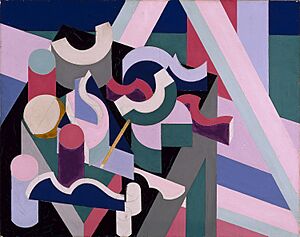
In the USA between World War I and World War II, painters often went to Europe for recognition. Artists like Marsden Hartley and Stuart Davis became known abroad. In New York City, Albert Pinkham Ryder and Ralph Blakelock were important figures in American painting from 1900 to 1920. In the 1920s, photographer Alfred Stieglitz showed works by Georgia O'Keeffe, Arthur Dove, and other American artists, as well as European masters like Henri Matisse and Pablo Picasso, at his gallery.
Social Consciousness in Art
-
George Grosz, 1920, Neue Sachlichkeit.
-
Thomas Hart Benton 1920, Regionalism.
-
George Bellows, 1924, American realism.
-
Charles Demuth Spring, 1921, American Precisionism (proto Pop Art).

During the 1920s and 1930s, and the Great Depression, Surrealism, late Cubism, the Bauhaus, De Stijl, Dada, and German Expressionism defined the European art scene. In Germany, Max Beckmann, Otto Dix, and George Grosz made their paintings political, hinting at World War II. In America, American Scene painting and the social realism and regionalism movements, which included political and social comments, dominated the art world. Artists like Ben Shahn and Grant Wood became famous. In Latin America, besides Joaquín Torres García and Rufino Tamayo, the muralist movement with Diego Rivera, David Siqueiros, and José Orozco, and the Symbolist paintings by Frida Kahlo started an art renaissance in the region, using color and historical and political messages. Frida Kahlo's Symbolist works are also strongly linked to Surrealism and Magic Realism in literature.
American Gothic is a painting by Grant Wood from 1930. It shows a farmer holding a pitchfork and a younger woman in front of a house. It's one of the most famous images in 20th-century American art. Art critics liked the painting, but some thought it was a joke about small-town life. However, with the start of the Great Depression, the painting came to be seen as showing the strong American pioneer spirit.
Diego Rivera is perhaps best known for his 1933 mural, "Man at the Crossroads", in the RCA Building at Rockefeller Center. When his patron Nelson Rockefeller found out the mural included a portrait of Vladimir Lenin and other communist images, he fired Rivera, and the unfinished work was destroyed. Frida Kahlo's (Rivera's wife) works often show pain. Of her 143 paintings, 55 are self-portraits, often showing her physical and emotional wounds with symbols. Kahlo was deeply influenced by Mexican culture, seen in her paintings' bright colors and dramatic symbolism.
Political activism was important to David Siqueiros, often making him put his art aside. His art was deeply rooted in the Mexican Revolution, a violent time in Mexican history. The period from the 1920s to the 1950s is known as the Mexican Renaissance, and Siqueiros worked to create art that was both Mexican and universal.
World Conflict and Art
-
Ernst Ludwig Kirchner, 1935–1937, German Expressionism.
-
Wassily Kandinsky Composition X 1939, Geometric abstraction.
During the 1930s, radical politics affected many artists linked to Surrealism, including Pablo Picasso. On April 26, 1937, during the Spanish Civil War, the town of Gernika was bombed by Nazi Germany's air force. The town was destroyed. Pablo Picasso painted his huge mural Guernica to remember the horrors of the bombing.
Guernica is a huge black and white mural, 3.5 meters tall and 7.8 meters wide, painted in oil. It shows death, suffering, and helplessness without directly showing the causes. The black and white colors make it look like a newspaper photograph.
Picasso painted Guernica to protest the bombing. It was first shown in Paris in 1937, then Scandinavia, then London in 1938. In 1939, Picasso asked for the painting to be sent to the United States for safekeeping. It toured museums in the USA for almost thirty years. Finally, in 1981, Picasso's wish to give the painting to the people of Spain was fulfilled, and it was sent to Spain.
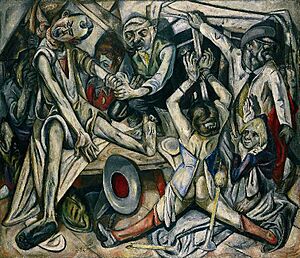
During the Great Depression of the 1930s and through World War II, American art focused on Social Realism and American Scene Painting by artists like Grant Wood and Edward Hopper. Nighthawks (1942) by Edward Hopper shows people in a downtown diner late at night. It's Hopper's most famous painting and one of the most recognizable in American art. It's in the Art Institute of Chicago. The scene was inspired by a diner in Hopper's neighborhood in Manhattan. Hopper started painting it right after the attack on Pearl Harbor. This event brought a feeling of gloom over the country, which is portrayed in the painting. The urban street is empty outside the diner, and inside none of the three patrons is apparently looking or talking to the others but instead is lost in their own thoughts. This portrayal of modern urban life as empty or lonely is a common theme throughout Hopper's work.
The situation for artists in Europe in the 1930s quickly worsened as the Nazis gained power in Germany and Eastern Europe. The environment became so hostile for artists and art linked to Modernism and abstraction that many left for the Americas. "Degenerate art" was a term used by the Nazis for almost all modern art. Such art was banned because it was seen as un-German or "Jewish Bolshevist." Artists identified as "degenerate" were punished, losing teaching jobs, being forbidden to exhibit or sell their art, and sometimes forbidden to create art at all.
"Degenerate Art" was also the title of an exhibition the Nazis put on in Munich in 1937. It showed modernist artworks hung in a messy way, with labels making fun of the art. This exhibition was meant to turn public opinion against modernism and later traveled to other German and Austrian cities. German artist Max Beckmann and many others fled Europe for New York. In New York City, a new generation of exciting Modernist painters, led by Arshile Gorky and Willem de Kooning, were just starting to become famous.
Arshile Gorky's portrait of someone who might be Willem de Kooning is an example of how abstract expressionism grew from figure painting, cubism, and surrealism. Along with his friends, Gorky created abstract, organic shapes that became completely abstract paintings by the 1940s. Gorky's work seems to be a careful study of memory, emotion, and shape, using lines and colors to express feelings and nature.
Mid-Century Art: Abstract Expressionism and Pop Art
The 1940s in New York City saw the rise of American abstract expressionism. This modernist movement combined ideas from Henri Matisse, Pablo Picasso, Surrealism, Joan Miró, Cubism, Fauvism, and early Modernism via great teachers in America like Hans Hofmann and John D. Graham. American artists benefited from the presence of Piet Mondrian, Fernand Léger, Max Ernst, and the André Breton group, Pierre Matisse's gallery, and Peggy Guggenheim's gallery The Art of This Century, as well as other factors. The figurative work of Francis Bacon, Frida Kahlo, Edward Hopper, Lucian Freud, Andrew Wyeth and others served as a kind of alternative to abstract expressionism.
Post-Second World War American painting called Abstract Expressionism included artists like Jackson Pollock, Willem de Kooning, Arshile Gorky, Mark Rothko, Hans Hofmann, Clyfford Still, Franz Kline, Adolph Gottlieb, Mark Tobey, Barnett Newman, James Brooks, Philip Guston, Robert Motherwell, Conrad Marca-Relli, Jack Tworkov, William Baziotes, Richard Pousette-Dart, Ad Reinhardt, Hedda Sterne, Jimmy Ernst, Esteban Vicente, Bradley Walker Tomlin, and Theodoros Stamos, among others. American Abstract Expressionism got its name in 1946 from art critic Robert Coates. It's seen as combining the strong emotion of German Expressionists with the non-realistic style of European abstract schools. Abstract Expressionism, action painting, and Color Field painting are all linked to the New York School.
Technically, Surrealism was an important influence on abstract expressionism, with its focus on spontaneous or subconscious creation. Jackson Pollock's technique of dripping paint onto a canvas on the floor has roots in the work of André Masson. Another early example of abstract expressionism is the work of American Northwest artist Mark Tobey, especially his "white writing" canvases, which look like Pollock's drip paintings.
Abstract Expressionism: Energy and Emotion
Abstract Expressionism is often seen as rebellious and unique. In reality, the term applies to many artists (mostly in New York) who had very different styles, and some of their work isn't even very abstract or expressionist. Pollock's energetic "action paintings" look very different from the strong and sometimes strange "Women" series by Willem de Kooning. As seen in the gallery, Woman V is one of six paintings de Kooning made between 1950 and 1953 showing a female figure. He worked on Woman I for a long time, changing it repeatedly. Art historian Meyer Schapiro encouraged him to continue. De Kooning then started three more paintings on the same theme. The Woman series are clearly figurative paintings. Another important artist is Franz Kline, whose painting High Street (1950) shows his spontaneous and intense style, focusing on brush strokes rather than figures.
Clyfford Still, Barnett Newman, Adolph Gottlieb, and the calm, shimmering blocks of color in Mark Rothko's work (which Rothko said was not abstract) are classified as abstract expressionists. Both Hans Hofmann and Robert Motherwell can be described as artists who used both action painting and Color Field painting.
Abstract Expressionism has many similarities to early 20th-century Russian artists like Wassily Kandinsky. While many abstract expressionist works seem spontaneous, most involved careful planning, especially due to their large size. Pollock's drip paintings might be an exception.
Why this style became widely accepted in the 1950s is debated. American Social realism was popular in the 1930s, influenced by the Great Depression and Mexican Social Realists like Diego Rivera. After World War II, the political mood didn't favor the social protests of those painters. Abstract Expressionism emerged during World War II and was shown in New York galleries in the early 1940s. The late 1940s through the mid-1950s was the McCarthy era. It was after World War II and a time of political conservatism and extreme artistic censorship in the United States. Some people have conjectured that since the subject matter was often totally abstract, Abstract Expressionism became a safe strategy for artists to pursue this style. Abstract art could be seen as apolitical. Or if the art was political, the message was largely for the insiders. However, those theorists are in the minority. As the first truly original school of painting in America, Abstract Expressionism demonstrated the vitality and creativity of the country in the post-war years, as well as its ability (or need) to develop an aesthetic sense that was not constrained by the European standards of beauty.
Although Abstract Expressionism spread quickly in the United States, its main centers were New York City and California. Abstract Expressionist paintings share certain features, like large canvases and an "all-over" approach, where the whole canvas is equally important. The canvas as the arena became a motto for action painting, while the integrity of the picture plane became a motto for Color Field painters. Many other artists started showing their abstract expressionist paintings
See also
 In Spanish: Historia de la pintura para niños
In Spanish: Historia de la pintura para niños


